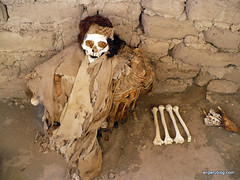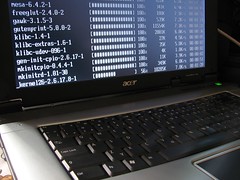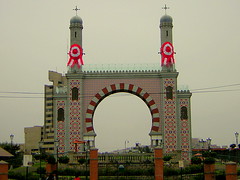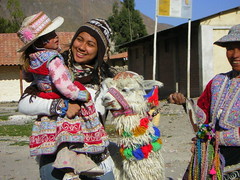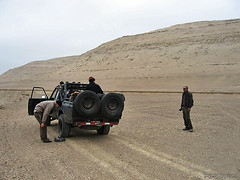Señor de Sipán
Peruvian archaeologist Walter Alva made world news in 1987 when he announced the greatest archaeological find since Tutankhamen in Egypt. When the grave of this Moche ruler was discovered, the archaeological community was amazed to find a burial so intact and yet more amazed at the unbelievable quantity of gold that accompanied this man, the Lord of Sipán.
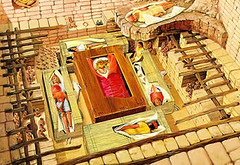
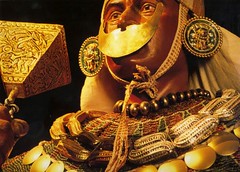
The Moche influence spread as far as the most northern parts of Peru and consisted of various peoples united by common culture, not a central political leadership. In the outskirts of modern Chiclayo is the town of Sipán, who’s name is formed partially by the word “si” meaning moon in Mochic. This may be a connection to the nearby ruins being used as a centre of worship of the moon. Named after this nearby town, which may be named after the ruins themselves, the Sipán complex and its primary structure, the great Huaca Rajada, gave up one of the worlds greatest finds.
| 1. Gold and copper banner 2. Gold and coper ornament 3. shell necklace 4. facial jewellery 5. necklace of nuts 10 gold and 10 silver 6. gold and turquoise earings 7. gold crown 8. shells and snails from Ecuador 9. more gold necklaces 10. gold and silver armour 11. another cold crown |
 |
Despite significant damage by grave robbers who targeted the larger structure, the burial site of this regional ruler in the smaller mausoleum structure to the side was relatively untouched. The tomb, buried under the smaller huaca is 5m by 5m and covered with criss-crossing beams of wood. The Lord of Sipán was placed in a coffin in this space with many precious objects (a small amount of which are described alongside the image on the left). He reigned approximately 200 A.D. and died
about 40 years of age.
The Lord of Sipán’s coffin was surrounded by the bodies of interesting figures killed to be buried with him. These were two young women, his wife, a child, a military commander, the doorkeeper, the guardian of the tomb, two llamas and a dog. The bodies of two
guards armed with shields and breastplates were also found and interestingly, the guardian
of the tomb previously mentioned had his feet removed to symbolize his
eternal obligation to keep watch. These people all played a role in helping him in the afterlife and were each included for a specific reason. The two llamas, for example, were needed to carry all the stuff he brought with him.
The amount of burial objects found with this man, and the tombs of an older ruler found to be of four generations before, as well as a priest and some others, made the construction of a large museum necessary to house it all. This museum in Lambayeque is the most modern in Peru and is amazing in the number of precious objects on display.
I could go on forever listing what was found, dozens of gold crowns, silver sandals and other bodies, as well as describe what they all were for, but I’d be describing the contents of a huge museum and several extremely large books. Only if I receive any requests will I go into more detail.
There are two sites to visit if you are interested in finding out more, both are close to Chiclayo. One is the new museum that puts the other in the country to shame. Displayed here are hundreds of gold and other fine objects, as well as reconstructions of the tombs and very detailed explanations. It would probably be best to pay for a guide to learn everything there is to know though. The other site to visit, on the opposite way out of the city, is the site of Sipán itself. Known as the Huaca Rajada, this archaeological site is only just recognisable as a pyramid complex after being heavily destroyed by rain in the past centuries.
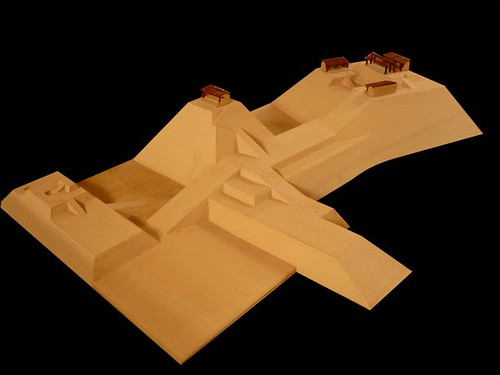
This Moche power centre sits in the middle of still-farmed cane fields, surrounded in the distance by as many as 20 other ancient constructions, now barely recognisable, consisting of temples and forts, one of which making the news recently by being discovered to be 4000 years old.
In the image above, on the left hand side, you will find the smaller huaca under which various generations of the ruling family were buried including the infamous Señor de Sipán.
The photos included (attached) in the blog are those of the Huaca Rajada in Sipán.
Related: London Police find Peru Treasure
Photos –
Tags: huaca, huaca rajada, lambayeque, moche, señor de sipán, sipán, walter alva



